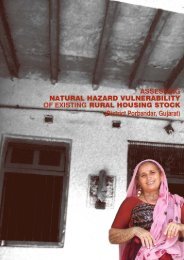Wastewater Irrigation in Gujarat - People in Centre Consulting
Wastewater Irrigation in Gujarat - People in Centre Consulting
Wastewater Irrigation in Gujarat - People in Centre Consulting
You also want an ePaper? Increase the reach of your titles
YUMPU automatically turns print PDFs into web optimized ePapers that Google loves.
Table 28: Comparison of <strong>Wastewater</strong> and Canal <strong>Irrigation</strong> Charges<br />
Sr.<br />
No.<br />
Cropp<strong>in</strong>g Pattern<br />
Area <strong>in</strong><br />
Ha<br />
Canal<br />
irrigation<br />
charge (per<br />
ha <strong>in</strong> Rs)<br />
Total<br />
canal<br />
irrigation<br />
charges<br />
(<strong>in</strong> Rs)<br />
1 BT Cotton 4 440 1760 8000<br />
Total of Cropp<strong>in</strong>g 4<br />
8000<br />
0<br />
Pattern 1<br />
2 Groundnut 1.5 220 330 8000<br />
Castor 1.5 220 330<br />
Vegetables 0.25 130 32.5<br />
Bajra fodder 0.25 90 22.5<br />
Wheat 2 240 480<br />
Total of Cropp<strong>in</strong>g 5.5 1195 8000<br />
Pattern 2<br />
Source: Information from the Sarpanch of Mota Dhavda village and field study, 2012<br />
Total<br />
wastewater<br />
irrigation<br />
charges<br />
(<strong>in</strong> Rs)<br />
It is evident that the charges for wastewater collected by gram panchayat are way<br />
higher than the canal irrigation charges. Despite the higher charges, 15 farmers are<br />
bidd<strong>in</strong>g for the wastewater, thereby, confirm<strong>in</strong>g the value of reliable and nutrient rich<br />
wastewater for agriculture. However, it is to be noted that this is a case, where canal<br />
water is not an option and the expenses on energy for draw<strong>in</strong>g groundwater are very<br />
high due to the depth of the groundwater. The cost of pump<strong>in</strong>g wastewater is<br />
additional for the farmer practic<strong>in</strong>g wastewater irrigation.<br />
Anandpar (Yaksha) Village<br />
The construction of STP and lay<strong>in</strong>g of underground sewage collection network took<br />
place <strong>in</strong> the year 2009 with the aid of Water and Sanitation Management<br />
Organization (WASMO). The total cost of the sewage and treatment system came to<br />
Rs. 35 lakhs and 10 percent of this amount was contributed by the village<br />
community. The village is small and has a population of 736 (Census 2001) and the<br />
number of households is 135 (Census 2001).<br />
Only one farmer has access to wastewater <strong>in</strong> this village whose land is near the STP.<br />
He has been pay<strong>in</strong>g Rs. 4,000 to the panchayat annually s<strong>in</strong>ce last three years for<br />
the use of wastewater. He has laid one kilometer long pipel<strong>in</strong>e to fetch the<br />
wastewater to his field and uses a 10 hp pump.<br />
Sanyra Village<br />
The STP was developed here along with lay<strong>in</strong>g of underground sewage collection<br />
network <strong>in</strong> the year 2010. The STP’s capacity is 0.20 MLD (2000 cubic meter) and<br />
operates at full capacity. It became operational <strong>in</strong> 2011 only. The population of the<br />
village is 1,427 (Census 2001) and the number of households is 264 (Census 2001).<br />
As the water is accessible to only one farmer, he has laid 0.35 kilometer long pipe to<br />
48




